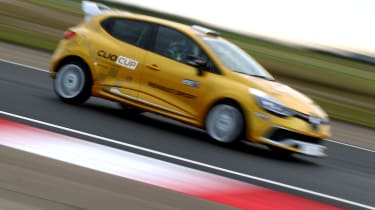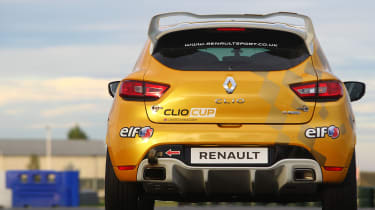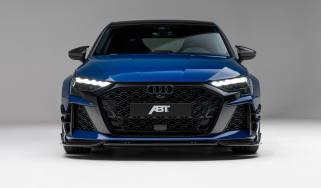Renault launches Clio Cup Junior series - and we drive it
Renault enters the 14-17 year old junior racing market with its scaled down Clio Cup touring car
Renault has announced a new Clio Junior series that will give drivers aged 14-17 a new option on the ladder towards motorsport stardom.
And far from being a basic Clio tweaked for racing purposes, the Junior cars are identical to the full Clio Cup cars you’ll have seen trading paint as a BTCC support series (and seen in evo's 2014 Track car of the year test).
While such a car might seem incredibly expensive for such young racers - a season's running costs are said to be around the £30,000 mark - the concept is actually very clever and could save money in the long run. For a start, it allows teams to compete in more than one series with the same vehicle, making only simple changes depending on whether it’s a Cup or Junior weekend.
It also allows drivers to compete at different levels - for example, spending a few seasons learning the ropes in the Junior series, before entering the full Cup without having to buy a new car. Financing will be available at favourable rates.
> More: Renault Sport Clio 220 Trophy review
And for the junior racers, it’s a far more relevant vehicle for those wishing to get into touring car racing than some of the more grassroots Junior-spec series.
At its simplest level, the Clio Junior car is a race-prepared version of the Clio 220 Trophy available for the road. The engine is the same 1.6-litre four-cylinder, the shell is the same as the road car’s, and things like suspension pick-up points (and the type of suspension itself) remain the same.
The race cars go on a diet though, before a roll-cage is fitted, the standard dual-clutch gearbox is swapped for a proper racing sequential ‘box, and the standard suspension is replaced by a fully-adjustable setup, with options to change toe and camber at the front and camber at the rear with shims.
The Junior cars go a step further. The Cup car’s slicks are replaced by road-going Michelin Pilot Sport 3 tyres, and an ECU tweak reduces boost and locks out sixth gear - as well as implementing an obligatory 100mph speed limiter.
And that’s effectively it - removing the ECU patch and putting on a set of slicks is all that’s required to upgrade the Junior car to a Cup car. While the engineers tried running a less aggressive suspension setup, 2009 Clio Cup champion and former BTCC and British GT racer Phil Glew discovered that the car actually worked perfectly well running the same setup as the car in its more powerful, grippier form.
Even more remarkably, the road tyres are proving incredibly durable. They should last several races in fact, but teams in the series will be limited to four tyres per meeting and a new set will be required for each race - negating any advantages for running worn tyres. The car in general is reliable too - it’s proving robust in the full Clio Cup series, and testing has suggested a team could do a full season in both the Cup and the Junior series on the same drivetrain, with no issues.
It’s safe to conclude that any 14-17 year old getting behind the wheel of the Junior car will be in for a real treat. We got a taste of the car on Bedford Autodrome’s long, flowing south west layout, which packs a mix of slow, medium and fast corners, virtually no elevation, and a smooth surface - all ideal for exploiting an unfamiliar car.
While not possessed of the same neck-straining grip as a car on slicks, the Junior finds amazing levels of grip from the Michelin tyres. With a firm setup and significant camber at both ends that’s perhaps unsurprising, but it’s more of a surprise to discover that the tyres don’t wilt after several laps of hard use - and that they’re the same set the team has used throughout testing.
They also find strong traction, aided by a tightly-wound limited-slip differential that drags the nose out of corners with real aggression: acclimatisation is a process of getting on the gas earlier and earlier through corners and each time being amazed that the nose doesn’t wash wide on corner exit.
It’s impressive how much grip the car finds on turn-in too, particularly with a touch of trail-braking to point the nose towards the apex. Brake hard and the tail squirms, but it’s always friendly and not the knife-edged machine you expect of an aggressively-balanced front-driver.
Friendly is the operative word for everything, in fact. Once you’ve pulled away from rest with the clutch (lots of revs, slip the clutch, manage not to stall, feel smug) you ignore it completely, flicking up and down the gearbox with paddles behind the steering wheel. Response is instant but it never feels dramatic - the lower boost means the race to the red line (denoted by a pair of blue flashing change-up lights) is no more than you’d expect from a mid-range hot hatch, and on the way back down the gearbox you take slow, steady flicks of the left-hand paddle to avoid locking a front wheel.
The soft limiter at 100mph also curtails the straight-line fun - it’s reached after about a third of the long back straight at Bedford - but this should keep the young racers safe, and with relatively extended braking periods on the road tyres, it’s likely to be outbraking manoeuvres rather than slipstreaming battles that keep the drivers on their toes.
But as well as being friendly, the car is incredibly good fun. The young racers be able to work with the Clio to improve their pace, but the limits aren’t so high that only a handful of competitors best able to exploit the car - as might happen on slick tyres and with more power - will run away with things.
Competition should be incredibly close - and with a significant proportion of the current BTCC grid made up of former Renault series graduates, there’s a fair chance that one or two Clio Junior winners will be BTCC champions of the future.







